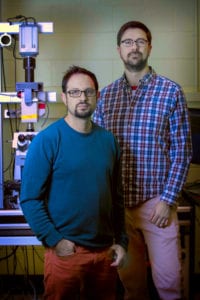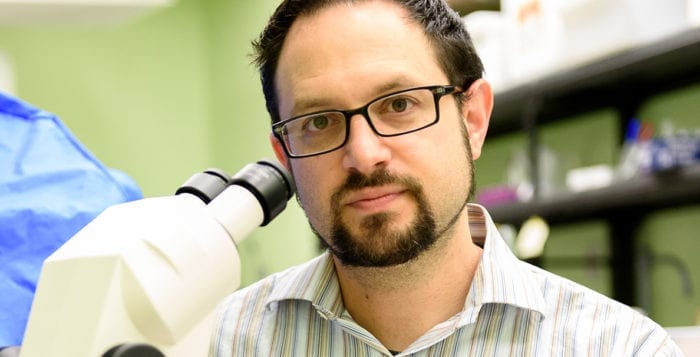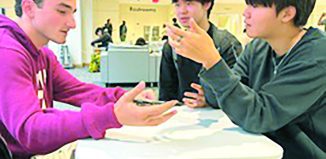SBU team explores division vs. invasion in fish, worm and cancer
By Daniel Dunaief
At first look, the connection between a roundworm, a zebrafish and cancer appears distant. After all, what can a transparent worm or a tropical fish native to India and the surrounding areas reveal about a disease that ravages its victims and devastates their families each year?
Plenty, when talking to David Matus and Benjamin Martin, assistant professors in the Department of Biochemistry and Cell Biology at Stony Brook University whose labs are next door to each other. The scientific tandem recently received the 2017 Damon Runyon–Rachleff Innovation Award, which includes a two-year grant of $300,000, followed by another renewable grant of $300,000 to continue this work.
In the first of a two-part series, Times Beacon Record Newspapers will profile the work of Matus this week. Next week the Power of Three will feature Martin’s research on zebrafish.
Long ago a scientist studying dolphin cognition in Hawaii, Matus has since delved into the world of genetic development, studying the roundworm, or, as its known by its scientific name, Caenorhabditis elegans. An adult of this worm, which lives in temperate soil environments, measures about 1 millimeter, which means it would take about 70 of them lined up end to end to equal the length of an average earthworm.

Matus specifically is interested in exploring how a cell called the anchor cell in a roundworm invades through the basement membrane, initiating a uterine-vulval connection that allows adult roundworms to pass eggs to the outside environment. He is searching for the signals and genetic changes that give the anchor cell its invasive properties.
Indeed, it was through a serendipitous discovery that he observed that the loss of a single gene results in anchor cells that divide but don’t invade. These dividing cells are still anchor cells, but they have lost the capacity to breach the basement membrane. That, Matus said, has led the team to explore the ways cancer has to decide whether to become metastatic and invade other cells or proliferate, producing more copies of itself. In some cancers, their hypothesis suggests, the cells either divide or invade and can’t do both at the same time. It could be a cancer multitasking bottleneck.
Mark Martindale, the director of the Whitney Laboratory at the University of Florida in Gainesville who was Matus’ doctoral advisor, said a cell’s decision about when to attach to other cells and when to let go involves cell polarity, the energetics of motility and a host of other factors that are impossible to study in a mammal.
The roundworm presents a system “in which it is possible to manipulate gene expression, and their clear optical properties make them ideal for imaging living cell behavior,” Martindale explained in an email. Seeing these developmental steps allows one to “understand a variety of biomedical issues.”
Last year, Matus and Martin were finalists for the Runyon–Rachleff prize. In between almost getting the award and this year, the team conducted imaging experiments in collaboration with Eric Betzig, a group leader at the Janelia Research Campus of the Howard Hughes Medical Institute in Ashburn, Virginia. Betzig not only brings expertise in optical imaging technologies but also has won a Nobel Prize.
“We really appreciate the opportunity to work with [Betzig] and his lab members on this project,” said Matus, who also published a review paper in Trends in Cell Biology that explored the link between cell cycle regulation and invasion. He and his graduate student Abraham Kohrman explored the literature to find cases that showed the same switching that he has been exploring with the roundworm.
Yusuf Hannun, the director of the Stony Brook Cancer Center, said the work is highly relevant to cancer as it explores fundamental issues about how cells behave when they invade, which is a key property of cancer cells. Hannun said the tandem’s hypothesis about division and invasion is “consistent with previous understandings but I believe this is the first time it is proposed formally,” he suggested in an email.
Their work could apply to invasive epithelial cancers, suggested Scott Powers, a professor in the Department of Pathology at Stony Brook and the director of Clinical Cancer Genomics at the Cancer Center. That could include breast, colon, prostate, lung and pancreatic cancers, noted Powers, who is a recent collaborator with Matus and Martin.
The additional funding allows Matus and Martin to focus more of their time on their research and less on applying for other grants, Matus said.

Matus lives in East Setauket with his wife Deirdre Killebrew, who works for Applied DNA Sciences. The couple met when they were working with dolphins in Hawaii. Matus’ first paper was on dolphin cognition, although he switched to evolutionary and developmental biology when he worked in Martindale’s lab at the University of Hawaii.
Martindale described Matus as prolific during his time in his lab, publishing numerous papers that were “profoundly important in our continued understanding of the relationship between genotype and phenotype and the evolution of biological complexity,” Martindale wrote in an email.
Following in Martindale’s footsteps, Matus replaced his middle name, Samuel, in publications with a Q. Martindale said several of his colleagues adopted the phony Q to pay homage to the attitude that drove them to pursue careers in science. Matus has now passed that Q on to Korhman, who is his first graduate student.
Matus and Killibrew have two daughters, Bria and Maille, who are 7 and 9 years old. Their children have a last name that combines each of their surnames, Matubrew. Matus said he feels “fortunate when I got here three years ago that they had me set up my lab next to [Martin]. That gave us an instantaneous atmosphere for collaboration.”







